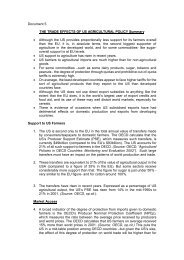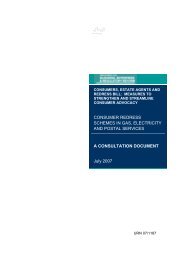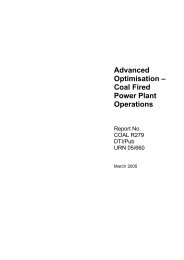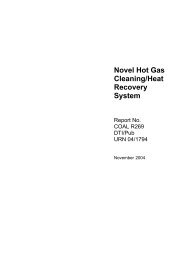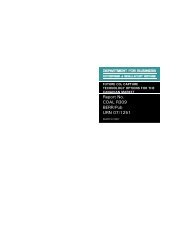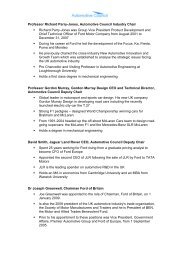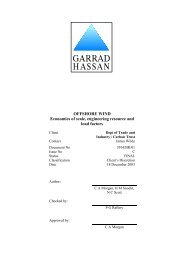(70) Therefore, the risk of sulphuric acid dew point attack ... - DTI Home
(70) Therefore, the risk of sulphuric acid dew point attack ... - DTI Home
(70) Therefore, the risk of sulphuric acid dew point attack ... - DTI Home
You also want an ePaper? Increase the reach of your titles
YUMPU automatically turns print PDFs into web optimized ePapers that Google loves.
3.8.2 Operating Costs<br />
Fixed operating costs, excluding fuel, are estimated to be around £12/kWyear<br />
for an existing CCGT plant [54] , although this could be higher for <strong>the</strong> most<br />
advanced class <strong>of</strong> GT plant due to GT maintenance costs. Generally, though,<br />
this represents <strong>the</strong> lowest value across <strong>the</strong> range <strong>of</strong> fossil fuel plant, <strong>the</strong> next<br />
lowest value being that <strong>of</strong> £14/kW for an existing coal fired plant without<br />
FGD. These CCGT fixed operating costs will again be dominated by <strong>the</strong> gas<br />
turbine, perhaps even more so than with <strong>the</strong> capital costs.<br />
Taking into account all costs (fuel cost at 23p/<strong>the</strong>rm, fixed operating cost and<br />
cost <strong>of</strong> capital), <strong>the</strong> estimated delivered energy cost for a CCGT in <strong>the</strong> UK is<br />
around 2.2p/kWh [53] .<br />
3.8.3 Reliability<br />
Reliability/availability will vary greatly depending upon <strong>the</strong> original build<br />
quality and design <strong>of</strong> <strong>the</strong> HRSG, <strong>the</strong> operating regime and <strong>the</strong> maintenance<br />
performed. EPRI [55] predicted <strong>the</strong>oretical total availability <strong>of</strong> a drum type<br />
HRSG to be 98.52% e.g. 1.48% availability loss. Powergen data from 1997-<br />
1999 [56] suggests a figure <strong>of</strong> around 0.2% average HRSG availability loss,<br />
which may be due to <strong>the</strong> relative youth <strong>of</strong> <strong>the</strong> plant and a fairly tight functional<br />
specification. The losses [56] appear to be mainly due to one <strong>of</strong> three causes;<br />
tube leaks, leaks from flange connections or trips due to incorrect (high or<br />
low) drum level on start up.<br />
A survey <strong>of</strong> <strong>the</strong> causes <strong>of</strong> tube leaks on Powergen CCGT and CHP plant<br />
indicates that around 50% are due to ‘wear out’ mechanisms such as flow<br />
accelerated corrosion, fretting, long term overheating, on load corrosion, stub<br />
weld cracking etc. The remaining 50% can roughly be categorised as arising<br />
ei<strong>the</strong>r from original manufacturing (usually weld) defects / previous site<br />
repairs or <strong>of</strong> being <strong>of</strong> a miscellaneous nature [57] .<br />
3.8.4 Maintenance<br />
As well as <strong>the</strong> scheduled routine maintenance (e.g. valve/pump maintenance,<br />
safety valve maintenance and testing, instrumentation checks, etc), typical<br />
preventative actions would include annual HRSG visual inspections <strong>of</strong>: -<br />
• HRSG/duct supports, expansion and alignment.<br />
• HRSG/duct external framing & internal stiffeners.<br />
• HRSG/duct internal insulation (if fitted).<br />
• Bypass damper and stack.<br />
• Main HRSG stack.<br />
• Tube modules and headers.<br />
• Duct fabric expansion joints (including <strong>the</strong>rmal imaging whilst on-load to<br />
identify areas operating at above-design temperatures and areas <strong>of</strong> gas<br />
leakage).<br />
• The condition and tightness <strong>of</strong> pipe penetration seals<br />
• The condition and movement <strong>of</strong> main feed and main steam pipe supports.<br />
(74)



